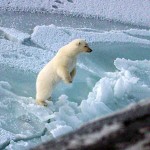Ozone layer over Arctic circle thins by a whopping 40 percent
Ozone layer depletion in the Arctic has reached an alarming level according to the United Nations' World Meteorological Organization.
The weather agency reported Tuesday that the protective layer in the earth's stratosphere over the Arctic region has dropped 40 percent this winter season, the largest reduction since monitoring began.
Antarctica's huge ozone hole is the one which gets more attention, but the North Pole is where scientists focus to get early signs as the ozone layer above it thins more rapidly because of high amounts of chlorofluorocarbons (CFCs) activated by ultraviolet light in the stratosphere.
The Arctic experiences ozone layer depletion seasonally up to around 30 percent. But this year's unusual combination of extremely cold temperature in the stratosphere and the increase in the CFCs from refrigeration and aerosol sprays have caused a new record-high of 40 percent depletion.
Scientists said that the thinning of the ozone layer was moving away from the North Pole into nearby Scandinavia and Greenland by late March.
"The Arctic stratosphere continues to be vulnerable to ozone destruction caused by ozone-depleting substances linked to human activities," said Michel Jarraud, the secretary-general of the World Meteorological Organization.
Thinning of the ozone layer occurs in cycles and the layer regenerates itself. But the increase of CFCs has been preventing the layer to revert to normal levels and scientists are worried that progressive thinning will compromise its ability to protect us from ultraviolet radiation.
CFCs, which have been curtailed since the 1987 Montreal Protocol, unfortunately have long life spans. It is expected that compounds released decades ago still contribute to the thinning of the ozone layer.
